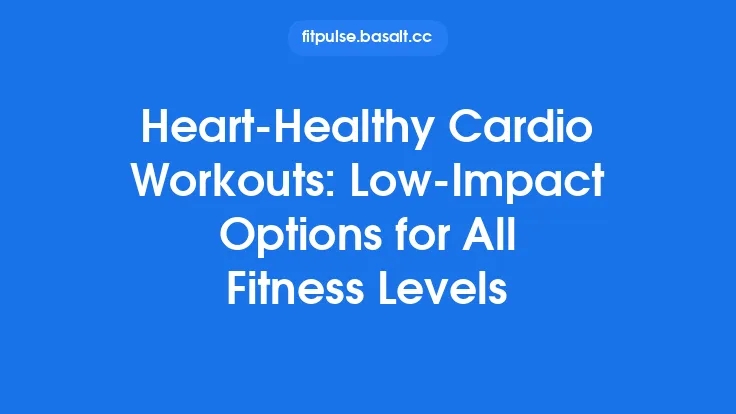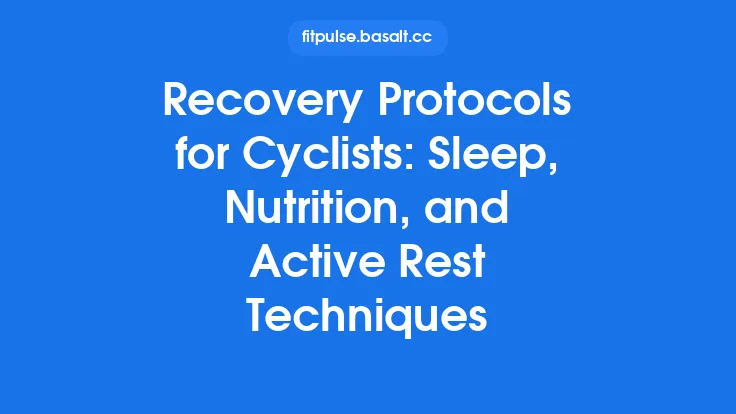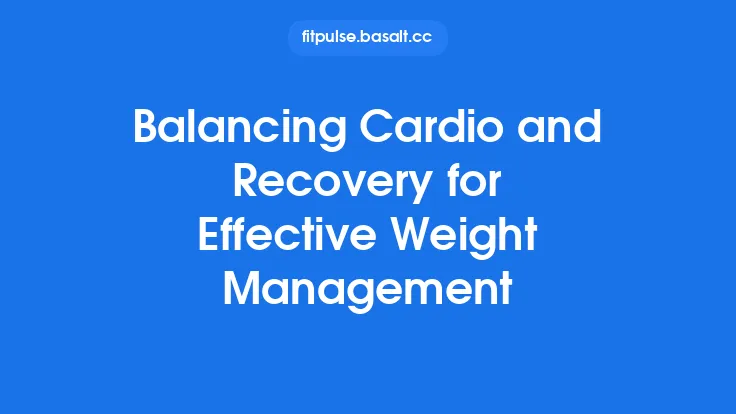Low‑impact cardio activities such as walking, cycling, and swimming are often overlooked in recovery plans, yet they provide a unique blend of gentle movement, increased circulation, and joint‑friendly stress that can accelerate the body’s natural repair processes. Unlike high‑intensity intervals or heavy resistance work, these modalities keep mechanical load low while still stimulating the cardiovascular system, promoting nutrient delivery, and flushing metabolic waste from fatigued muscles. When integrated thoughtfully, they become powerful tools for athletes, fitness enthusiasts, and anyone looking to stay active without compromising recovery.
Understanding Low‑Impact Cardio for Recovery
Low‑impact cardio refers to aerobic exercise that minimizes compressive forces on the musculoskeletal system. The hallmark characteristics include:
- Reduced Ground Reaction Forces (GRF): Activities like walking on a flat surface, pedaling on a smooth road, or gliding through water generate far less impact than running or jumping, protecting joints and connective tissue.
- Steady‑State Aerobic Stimulus: Maintaining a moderate, continuous pace elevates heart rate enough to improve blood flow without triggering the high‑stress hormonal cascade associated with intense bouts.
- Enhanced Lymphatic Drainage: Rhythmic, low‑intensity movement encourages lymphatic circulation, which assists in clearing inflammatory by‑products and reducing swelling.
- Neuromuscular Reset: The repetitive, low‑load motion reinforces proper movement patterns, helping to correct subtle gait or posture deviations that may have arisen during heavy training.
Because these qualities are largely independent of sport‑specific demands, walking, cycling, and swimming serve as universal recovery modalities across disciplines.
Walking: Techniques and Variations
1. Biomechanical Foundations
A proper walking technique begins with a neutral pelvis, relaxed shoulders, and a slight forward lean from the ankles—not the waist. The foot should strike the ground heel‑first, roll through the midfoot, and push off with the toes. This “heel‑to‑toe” progression encourages a smooth kinetic chain, reducing unnecessary stress on the knees and hips.
2. Pace and Duration
For active recovery, aim for a moderate‑intensity pace—fast enough to raise breathing slightly but still allow conversation. Typically, this corresponds to 3–4 mph (4.8–6.4 km/h) for most adults. Sessions of 20–45 minutes are sufficient to stimulate circulation without depleting glycogen stores.
3. Terrain Options
| Terrain | Benefits | Considerations |
|---|---|---|
| Flat sidewalks or tracks | Predictable GRF, easy pacing | May become monotonous |
| Gentle inclines (2–4 % grade) | Slightly higher cardiovascular demand, engages glutes and calves | Keep incline modest to avoid excessive eccentric loading |
| Nature trails (soft earth) | Reduced impact, mental refreshment | Watch for uneven surfaces that could compromise stability |
4. Enhancements for Recovery
- Arm swing: Actively drive the opposite arm forward with each step to promote thoracic mobility.
- Stride length: Keep steps short; over‑striding increases braking forces and can negate the low‑impact advantage.
- Post‑walk stretch: A brief series of calf, hamstring, and hip‑flexor stretches can lock in the mobility gains from the walk.
Cycling: Choosing the Right Bike and Ride Structure
1. Bike Selection
| Type | Ideal Use for Recovery | Key Features |
|---|---|---|
| Road bike (light frame) | Faster, smoother rides on paved surfaces | Narrow tires, aerodynamic position—ensure saddle height is comfortable to avoid hip strain |
| Hybrid/fitness bike | Versatile, suitable for both pavement and light trails | Wider tires for stability, upright geometry reduces lower‑back stress |
| Recumbent bike | Maximal joint comfort, especially for knee or lower‑back issues | Seated, reclined position distributes weight evenly |
2. Fit Essentials
A proper bike fit is crucial to keep the activity low‑impact. The saddle should be level, positioned so that a slight bend (≈25–30°) remains in the knee at the bottom of the pedal stroke. Handlebars should allow a relaxed grip without excessive forward lean, preserving spinal alignment.
3. Ride Cadence and Resistance
- Cadence: Aim for 80–90 revolutions per minute (rpm). A higher cadence at low resistance mimics the smooth, low‑load pattern desirable for recovery.
- Resistance: Keep gear selection light; you should be able to maintain the target cadence without feeling a strong muscular burn.
- Duration: 30–60 minutes is typical, with the first 5–10 minutes serving as a gentle warm‑up and the final 5 minutes as a cool‑down.
4. Variations
- Flat‑road cruise: Steady pace on level terrain, ideal for pure cardiovascular stimulus.
- Gentle rolling hills: Small elevation changes (≤3 % grade) add a mild challenge to the heart without imposing high eccentric loads on the legs.
- Indoor spin (static bike): Allows precise control over resistance and environment; useful when weather or safety concerns limit outdoor riding.
Swimming: Stroke Selection and Session Design
1. Why Water Is a Recovery Medium
Water’s buoyancy reduces effective body weight by up to 90 %, dramatically lowering joint compression. Simultaneously, water’s viscosity provides gentle resistance, encouraging muscular activation without heavy loading. The hydrostatic pressure also aids in reducing peripheral edema.
2. Stroke Choices
| Stroke | Recovery Profile | Technique Tips |
|---|---|---|
| Freestyle (front crawl) | Balanced cardio and upper‑body activation | Keep a relaxed, elongated arm pull; focus on a steady, rhythmic breathing pattern. |
| Backstroke | Emphasizes posterior chain and shoulder mobility | Maintain a neutral neck; avoid excessive arching of the lower back. |
| Breaststroke | Low‑intensity, gentle on the shoulders | Use a slow, gliding tempo; ensure the kick is small and controlled to limit knee strain. |
| Aquatic walking/jogging (shallow water) | Full‑body low‑impact movement | Mimic land‑based walking while the water provides resistance; keep steps light and quick. |
3. Session Structure
- Warm‑up (5 min): Light water walking or easy freestyle at a relaxed pace.
- Main set (15–30 min): Choose a single stroke and maintain a steady, conversational effort. For example, 3 × 5 min intervals with 30 seconds rest between each, or a continuous 20‑minute swim.
- Cool‑down (5 min): Slow, gentle strokes or floating with deep breathing to promote relaxation.
4. Equipment Considerations
- Swim cap and goggles improve comfort and visibility, encouraging longer sessions.
- Pull buoy can be added for upper‑body focus, but use sparingly to keep the load low.
- Kickboard is useful for isolating the lower body if you need a brief leg‑only segment.
Comparative Benefits and Choosing the Right Modality
| Factor | Walking | Cycling | Swimming |
|---|---|---|---|
| Joint Load | Very low (especially on soft surfaces) | Low to moderate (depends on bike fit) | Minimal (buoyancy eliminates weight‑bearing) |
| Cardiovascular Stimulus | Moderate, easy to gauge by perceived effort | Adjustable via cadence/resistance | Moderate; water resistance adds subtle load |
| Accessibility | Requires only shoes; can be done anywhere | Needs a bike or indoor trainer; storage may be a factor | Requires pool access and basic swimming ability |
| Caloric Expenditure (approx.) | 200–300 kcal/hr (moderate pace) | 300–500 kcal/hr (steady ride) | 250–400 kcal/hr (continuous swim) |
| Recovery‑Specific Advantages | Improves venous return, promotes joint lubrication | Enhances lower‑body circulation, low‑impact on knees | Reduces swelling via hydrostatic pressure, promotes full‑body relaxation |
Decision guide:
If joint pain or limited mobility is a primary concern, swimming offers the gentlest impact.
If you prefer outdoor activity and want a simple, equipment‑light option, walking is ideal.
If you enjoy a slightly higher calorie burn and have access to a bike, cycling provides a versatile middle ground.
Practical Tips for Incorporating Low‑Impact Cardio into Recovery Days
- Schedule After Heavy Sessions: Place the cardio activity 24 hours after a demanding workout to capitalize on the heightened blood flow needed for repair.
- Keep Intensity “Recovery‑Level”: Aim for a perceived exertion of 3–4 on a 10‑point scale (easy to moderate). You should be able to speak in full sentences without gasping.
- Hydrate and Fuel Lightly: Since the goal isn’t to deplete glycogen, a small carbohydrate snack (e.g., a banana) before the session can sustain energy without hindering recovery.
- Mind the Environment: Choose shaded routes for walking, smooth roads for cycling, and comfortably warm water (≈27–29 °C) for swimming to avoid unnecessary stress.
- Track Time, Not Metrics: Use a simple stopwatch or timer to ensure you stay within the recommended 20–60 minute window. Consistency matters more than precise heart‑rate zones for recovery purposes.
- Integrate Mobility Drills: After the cardio, spend 5–10 minutes on gentle mobility work (ankle circles, thoracic rotations) to lock in the range‑of‑motion benefits.
Common Pitfalls and How to Avoid Them
| Pitfall | Why It Undermines Recovery | Prevention |
|---|---|---|
| Going too fast or too far | Elevates cortisol and creates additional muscle micro‑damage | Stick to the “conversation pace” and set a timer to limit session length |
| Neglecting proper footwear or bike fit | Increases risk of joint irritation and post‑exercise soreness | Invest in supportive walking shoes and have a bike professionally fitted |
| Skipping the warm‑up/cool‑down | Sudden changes in circulation can cause stiffness or light‑headedness | Allocate at least 5 minutes at each end for easy movement and stretching |
| Choosing overly challenging terrain (e.g., steep hills, rough trails) | Reintroduces high‑impact forces, defeating the low‑impact purpose | Opt for gentle grades and smooth surfaces, especially on recovery days |
| Holding breath or tensing muscles | Reduces oxygen delivery and adds unnecessary muscular strain | Practice relaxed breathing; focus on fluid, rhythmic movement |
| Using the activity as a “punishment” for missed workouts | Turns recovery into a stressor, potentially leading to overtraining | Reframe the session as a restorative, enjoyable movement rather than a chore |
Frequently Asked Questions
Q: Can I combine more than one low‑impact cardio modality in a single recovery day?
A: Yes. A short walk followed by a brief swim or a light bike ride can provide varied stimulus while keeping overall intensity low. Just ensure the total active time stays within the 60‑minute range to avoid cumulative fatigue.
Q: How often should I schedule low‑impact cardio for optimal recovery?
A: Most athletes benefit from 1–2 sessions per week, placed on days following heavy training or competition. Adjust frequency based on how your body feels; the goal is to enhance recovery, not to add another stressor.
Q: Is it okay to wear a heart‑rate monitor during these sessions?
A: Monitoring can be useful for personal curiosity, but it is not required for effective recovery. Focus on perceived effort and comfort rather than hitting specific zones.
Q: Will these activities replace the need for rest days?
A: No. Active recovery complements, but does not substitute, full rest days. Complete rest is still essential for hormonal balance and mental rejuvenation.
Q: I have mild knee pain—should I choose walking, cycling, or swimming?
A: Swimming is generally the safest option because buoyancy removes load from the knee joint. If a pool isn’t accessible, a stationary bike with low resistance is a good alternative; walking can be done on soft surfaces with a careful gait.
Incorporating walking, cycling, and swimming as low‑impact cardio options offers a scientifically grounded pathway to accelerate recovery, maintain cardiovascular fitness, and protect the musculoskeletal system from unnecessary strain. By selecting the modality that aligns with personal preferences, equipment availability, and specific joint considerations, athletes and active individuals can turn recovery days into purposeful, enjoyable sessions that support long‑term performance and injury prevention.





